Geophagic Clays from Cameroon: Provenance, Metal Contamination and Health Risk Assessment
Abstract
:1. Introduction
2. Materials and Methods
2.1. Materials
2.2. Laboratory Analyses
2.3. Trace Metal Contamination Assessment
2.4. Human Health Risk Assessment
- If the HI < 1, no risk of non- carcinogenic effects is believed to occur.
- If the HI value > 1, there is probability of potential non-carcinogenic effects on humans.
3. Results
3.1. Mineralogy
3.2. Geochemistry
4. Discussion
4.1. Provenance of Geophagic Clays
4.1.1. Weathering and Source Rocks of Geophagic Clays
4.1.2. Sediment Sorting and Recycling
4.2. Contamination Assessment
4.2.1. Enrichment Factor (EF)
4.2.2. Index of Geo-Accumulation (Igeo)
4.3. Health Risk Assessment
5. Conclusions
Supplementary Materials
Author Contributions
Funding
Institutional Review Board Statement
Informed Consent Statement
Data Availability Statement
Conflicts of Interest
References
- Ekosse, G.E.; De Jager, L.; Ngole, V. Traditional Mining and Mineralogy of Geophagic Clays from Limpopo and Free State Provinces, South Africa. Afr. J. Biotechnol. 2010, 9, 8058–8067. [Google Scholar]
- Ngole, V.M.; Ekosse, G.E.; de Jager, L.; Songca, S.P. Physicochemical Characteristics of Geophagic Clayey Soils from South Africa and Swaziland. Afr. J. Biotechnol. 2010, 9, 5929–5937. [Google Scholar]
- George, G.; Ndip, E. Prevalence of Geophagia and Its Possible Implications to Health—A Study in Rural South Africa; IACSIT Press: Singapore, 2011; Volume 4, pp. 166–169. [Google Scholar]
- Mogongoa, L.F.; Brand, C.E.; De Jager, L.; Ekosse, G.E. Haematological and Iron Status of Qwa Qwa Women in South Africa Who Ingest Clays: Peer Reviewed Original Article. Med. Technol. SA 2011, 25, 33–37. [Google Scholar]
- Sumbele, I.U.; Ngole, V.M.; Ekosse, G.-I.E. Influence of Physico-Chemistry and Mineralogy on the Occurrence of Geohelminths in Geophagic Soils from Selected Communities in the Eastern Cape, South Africa, and Their Possible Implication on Human Health. Int. J. Environ. Health Res. 2014, 24, 18–30. [Google Scholar] [CrossRef]
- Young, S.L.; Wilson, M.J.; Hillier, S.; Delbos, E.; Ali, S.M.; Stoltzfus, R.J. Differences and Commonalities in Physical, Chemical and Mineralogical Properties of Zanzibari Geophagic Soils. J. Chem. Ecol. 2010, 36, 129–140. [Google Scholar] [CrossRef] [Green Version]
- Grigsby, R.K.; Thyer, B.A.; Waller, R.J.; Johnston, G.A. Chalk Eating in Middle Georgia: A Culture-Bound Syndrome of Pica? South. Med. J. 1999, 92, 190–192. [Google Scholar] [CrossRef]
- Decaudin, P.; Kanagaratnam, L.; Kmiec, I.; Nguyen, Y.; Migault, C.; Lebrun, D.; Hentzien, M.; Bertin, E.; Drame, M.; Bani-Sadr, F. Prevalence of Geophagy and Knowledge about Its Health Effects among Native Sub-Saharan Africa, Caribbean and South America Healthy Adults Living in France. Eat. Weight Disord. 2020, 25, 465–469. [Google Scholar] [CrossRef] [PubMed]
- Madziva, C.; Chinouya, M.J. Clay Ingestion During Pregnancy Among Black African Women in a North London Borough: Understanding Cultural Meanings, Integrating Indigenous and Biomedical Knowledge Systems. Front. Sociol. 2020, 5, 20. [Google Scholar] [CrossRef] [PubMed] [Green Version]
- Odongo, A.O.; Moturi, W.N.; Mbuthia, E.K. Heavy Metals and Parasitic Geohelminths Toxicity among Geophagous Pregnant Women: A Case Study of Nakuru Municipality, Kenya. Environ. Geochem Health 2016, 38, 123–131. [Google Scholar] [CrossRef]
- Gundacker, C.; Kutalek, R.; Glaunach, R.; Deweis, C.; Hengstschläger, M.; Prinz, A. Geophagy during Pregnancy: Is There a Health Risk for Infants? Environ. Res. 2017, 156, 145–147. [Google Scholar] [CrossRef]
- Lar, U.A.; Agene, J.I.; Umar, A.I. Geophagic Clay Materials from Nigeria: A Potential Source of Heavy Metals and Human Health Implications in Mostly Women and Children Who Practice It. Environ. Geochem. Health 2015, 37, 363–375. [Google Scholar] [CrossRef]
- Diko, M.L.; Ekosse, G.E. Soil Ingestion and Associated Health Implications: A Physicochemical and Mineralogical Appraisal of Geophagic Soils from Moko, Cameroon. Stud. Ethno-Med. 2014, 8, 83–88. [Google Scholar] [CrossRef]
- Gilg, H.A.; Hulmeyer, S.; Miller, H.; Sheppard, S.M.F. Supergene Origin of the Lastarria Kaolin Deposit, South-Central Chile, and Paleoclimatic Implications. Clays Clay Miner. 1999, 47, 201–211. [Google Scholar] [CrossRef]
- Bloodworth, A.J.; Highley, D.E.; Mitchell, C.J. Industrial Minerals Laboratory Manual: Kaolin; Technical Report WG/93/1; British Geological Survey, Mineralogy and Petrology Group: Nottingham, UK, 1993; p. 80. [Google Scholar]
- Ekosse, E.G.-I.; Jumbam, N.D. Geophagic Clays: Their Mineralogy, Chemistry and Possible Human Health Effects. Afr. J. Biotechnol. 2010, 40, 6755–6767. [Google Scholar]
- Fosso-Kankeu, E.; Netshitanini, T.L.; Abia, A.L.K.; Ubomba-Jaswa, E.; Waanders, F.B. Application of Solar Treatment for the Disinfection of Geophagic Clays from Markets and Mining Sites. Afr. J. Biotechnol. 2015, 16, 3313–3324. [Google Scholar] [CrossRef]
- Kumar, A.; Cabral-Pinto, M.; Kumar, A.; Kumar, M.; Dinis, P.A. Estimation of Risk to the Eco-Environment and Human Health of Using Heavy Metals in the Uttarakhand Himalaya, India. Appl. Sci. 2020, 10, 7078. [Google Scholar] [CrossRef]
- Selinus, O. Essentials of Medical Geology: Revised Edition; Springer: Dordrecht, The Netherlands, 2013; ISBN 9789400743748. [Google Scholar]
- Jumbam, N.D. Geophagic Materials: The Possible Effects of Their Chemical Composition on Human Health. Trans. R. Soc. S. Afr. 2013, 68, 177–182. [Google Scholar] [CrossRef]
- Momoh, A.; Ojo, O.J.; Odewumi, S.C.; Sibiya, B.K. Preliminary Results of Selected Toxic Trace Elements in Geophagic Clays from the Vhembe District, South Africa. J. Min. Geol. 2013, 49, 121–127. [Google Scholar]
- Nkansah, M.A.; Korankye, M.; Darko, G.; Dodd, M. Heavy Metal Content and Potential Health Risk of Geophagic White Clay from the Kumasi Metropolis in Ghana. Toxicol. Rep. 2016, 3, 644–651. [Google Scholar] [CrossRef] [PubMed] [Green Version]
- Kumar, A.; Kumar, A.; Cabral-Pinto, M.; Chaturvedi, A.K.; Shabnam, A.A.; Subrahmanyam, G.; Mondal, R.; Gupta, D.K.; Malyan, S.K.; Kumar, S.S.; et al. Lead Toxicity: Health Hazards, Influence on Food Chain, and Sustainable Remediation Approaches. Int. J. Environ. Res. Public Health 2020, 17, 2179. [Google Scholar] [CrossRef] [PubMed] [Green Version]
- Orisakwe, O.E.; Udowelle, N.A.; Azuonwu, O.; Nkeiruka, I.Z.; Nkereuwem, U.A.; Frazzoli, C. Cadmium and Lead in Geophagic Clay Consumed in Southern Nigeria: Health Risk from Such Traditional Nutraceutical. Environ. Geochem. Health 2020, 42, 3865–3875. [Google Scholar] [CrossRef] [PubMed]
- Oyebanjo, O.; Ekosse, G.-I.; Odiyo, J. Health Risk Evaluation of Trace Elements in Geophagic Kaolinitic Clays within Eastern Dahomey and Niger Delta Basins, Nigeria. Int. J. Environ. Res. Public Health 2020, 17, 4813. [Google Scholar] [CrossRef] [PubMed]
- Diko, M.; Siewe épse Diko, C. Physico-Chemistry Of Geophagic Soils Ingested To Relief Nausea And Vomiting During Pregnancy. Afr. J. Tradit. Complement. Altern. Med. 2014, 11, 21–24. [Google Scholar] [CrossRef] [Green Version]
- Frazzoli, C.; Pouokam, G.B.; Mantovani, A.; Orisakwe, O.E. Health Risks from Lost Awareness of Cultural Behaviours Rooted in Traditional Medicine: An Insight in Geophagy and Mineral Intake. Sci. Total Environ. 2016, 566–567, 1465–1471. [Google Scholar] [CrossRef]
- Bongslain, J.N.; Chelea, M.; Tsafack, T.J.J.; Djiele, P.N.; Ngonde, E.M.C. Assessment of Haemoglobin Status and Transplacental Transport of Lead and Calcium During Geophagy. Nutr. Disord. 2017, 7, 204. [Google Scholar] [CrossRef] [Green Version]
- Essome, H.; Engbang, J.P.; Ndedi, G.P.; Valere, M.K.; Boten, M.; Foumane, P.; Adiogo, D. Kaolin Clay Consumption and Pregnancy: Prevalence, Hematological Consequences and Outcome of Labour in the Douala. Open J. Obstet. Gynecol. 2017, 7, 1166–1173. [Google Scholar] [CrossRef] [Green Version]
- Ninla, S.A.D.; Wouatong, A.S.L.; Kouonang, S.T.; Yerima, B.; Njopwouo, D. Mineralogical and Physico-Chemical Characterization of Clayey Materials of Meka’a (West Cameroon) Preliminary Step for Their Utilization for Human Ingestion. Earth Sci. 2018, 7, 74–85. [Google Scholar]
- Kenne Kalguem, E.D.; Wouatong, A.S.L.; Njopwouo, D.; Ekosse, G. Physico-Chemical Characterization of Clayey Materials Consumed by Geophagism in Locality of Sabga (North-Western Cameroon): Health Implications. Int. J. Appl. Sci. Technol. 2018, 8, 57–68. [Google Scholar] [CrossRef] [Green Version]
- Kenne Kalguem, E.D.; Wouatong, A.S.L.; Njopwouo, D.; Kemteu, C.S.; Ekosse, G. Geophagic Clayey Materials of Sabga Locality (North West Cameroon): Genesis and Medical Interest. Earth Sci. 2019, 8, 45–59. [Google Scholar] [CrossRef] [Green Version]
- Diko, M.L.; Ekosse, G.-I.E. Investigation of Kaolinite Structural Order in Geophagic Soils by Infrared Spectroscopy: An Empirical Approach. Trans. R. Soc. South. Afr. 2020, 75, 159–164. [Google Scholar] [CrossRef]
- Van Reeuwijk, L.P. Procedures for Soil Analysis, 6th ed.; Technical Paper; International Soil Reference and Information Centre: Wageningen, The Netherlands, 2002; ISBN 90-6672-052-2. [Google Scholar]
- Feret, F.R.; Roy, D.; Boulanger, C. Determination of Alpha and Beta Alumina in Ceramic Alumina by X-Ray Diffraction. Spectrochim. Acta Part B At. Spectrosc. 2000, 55, 1051–1061. [Google Scholar] [CrossRef]
- Paranthaman, R.; Moses, J.A.; Anandharamakrishnan, C. A Powder X-Ray Diffraction Method for Qualitative Detection of Potassium Bromate in Bakery Ingredients and Products. Food Anal. Methods 2021, 14, 1054–1063. [Google Scholar] [CrossRef]
- Fitton, G. X-ray fluorescence spectrometry. In Modern Analytical Geochemistry; Gill, R., Ed.; Addison Wesley Longman: Harlow, UK, 1997; pp. 135–153. [Google Scholar]
- Jochum, K.P.; Nohl, U.; Herwig, K.; Lammel, E.; Stoll, B.; Hofmann, A.W. GeoReM: A New Geochemical Database for Reference Materials and Isotopic Standards. Geostand. Geoanalyt. Res. 2005, 29, 333–338. [Google Scholar] [CrossRef]
- Jochum, K.P.; Weis, U.; Schwager, B.; Stoll, B.; Wilson, S.A.; Haug, G.H.; Andreae, M.O.; Enzweiler, J. Reference Values Following ISO Guidelines for Frequently Requested Rock Reference Materials. Geostand. Geoanal. Res. 2016, 40, 333–350. [Google Scholar] [CrossRef]
- Ayala-Pérez, M.P.; Armstrong-Altrin, J.S.; Machain-Castillo, M.L. Heavy Metal Contamination and Provenance of Sediments Recovered at the Grijalva River Delta, Southern Gulf of Mexico. J. Earth Syst. Sci. 2021, 130, 1–23. [Google Scholar] [CrossRef]
- Ekoa Bessa, A.Z.; Ngueutchoua, G.; Janpou, A.K.; El-Amler, Y.A.; Nguetnga, O.A.N.N.M.; Kankeu Kayou, U.R.; Bisse, S.B.; Ngo Mapuna, E.C.; Armstrong-Altrin, J.S. Heavy Metal Contamination and Its Ecological Risks in the Beach Sediments along the Atlantic Ocean (Limbe Coastal Fringes, Cameroon). Earth Syst. Environ. 2020, 5, 433–444. [Google Scholar] [CrossRef]
- Salati, S.; Moore, F. Assessment of Heavy Metal Concentration in the Khoshk River Water and Sediment, Shiraz, Southwest Iran. Environ. Monit Assess. 2010, 164, 677–689. [Google Scholar] [CrossRef]
- Rudnick, R.L.; Gao, S. 3.01 Composition of the Continental Crust. In Treatise On Geochemistry; Elsevier: Amsterdam, The Netherlands, 2003; Volume 3, p. 64. ISBN 978-0-08-043751-4. [Google Scholar]
- Muller, G. Index of Geoaccumulation in Sediments of the Rhine River. Geojournal 1969, 2, 108–118. [Google Scholar]
- Chen, H.; Teng, Y.; Lu, S.; Wang, Y.; Wang, J. Contamination Features and Health Risk of Soil Heavy Metals in China. Sci. Total Environ. 2015, 512–513, 143–153. [Google Scholar] [CrossRef]
- Adimalla, N. Heavy Metals Contamination in Urban Surface Soils of Medak Province, India, and Its Risk Assessment and Spatial Distribution. Environ. Geochem. Health 2020, 42, 59–75. [Google Scholar] [CrossRef]
- US Environmental Protection Agency (USEPA). Risk Assessment Guidance for Superfund; Office of Emergency and Remedial Response: Washington, DC, USA, 1989.
- Li, F.; Zhang, J.; Cao, T.; Li, S.; Chen, Y.; Liang, X.; Zhao, X.; Chen, J. Human Health Risk Assessment of Toxic Elements in Farmland Topsoil with Source Identification in Jilin Province, China. Int. J. Environ. Res. Public Health 2018, 15, 1040. [Google Scholar] [CrossRef] [PubMed] [Green Version]
- US Environmental Protection Agency (USEPA). Risk Assessment Guidance for Superfund; Office of Emergency and Remedial Response: Washington, DC, USA, 2004.
- Cox, R.; Lowe, D.R.; Cullers, R.L. The Influence of Sediment Recycling and Basement Composition on Evolution of Mudrock Chemistry in the Southwestern United States. Geochim. Cosmochim. Acta 1995, 59, 2919–2940. [Google Scholar] [CrossRef]
- Nesbitt, H.W.; Young, G.M. Early Proterozoic Climates and Plate Motions Inferred from Major Element Chemistry of Lutites. Nature 1982, 299, 715–717. [Google Scholar] [CrossRef]
- Ahmad, A.H.M.; Noufal, K.N.; Masroor, A.M.; Khan, T. Petrography and Geochemistry of Jumara Dome Sediments, Kachchh Basin: Implications for Provenance, Tectonic Setting and Weathering Intensity. Chin. J. Geochem. 2014, 33, 9–23. [Google Scholar] [CrossRef]
- Akinyemi, S.A.; Ogunniyi, S.O.; Ojo, A.O.; Gitari, W.M.; Momoh, A.; Akinola, O.O.; Talabi, A.O.; Afolagboye, L.O.; Olaorun, O.A.; Ayodele, O.S. Mineralogical, Physicochemical Characteristics and Industrial Potential of Some Residual Clay Deposits within Ekiti State, Southern Nigeria. J. Environ. Earth Sci. 2014, 4, 70–88. [Google Scholar]
- Nagarajan, R.; Roy, P.D.; Jonathan, M.P.; Lozano, R.; Kessler, F.L.; Prasanna, M.V. Geochemistry of Neogene Sedimentary Rocks from Borneo Basin, East Malaysia: Paleo-Weathering, Provenance and Tectonic Setting. Chem. Der Erde 2014, 74, 139–146. [Google Scholar] [CrossRef]
- Fedo, C.M.; Nesbitt, H.W.; Young, G.M. Unraveling the Effects of Potassium Metasomatism in Sedimentary Rocks and Paleosols, with Implications for Paleoweathering Conditions and Provenance. Geology 1995, 23, 921–924. [Google Scholar] [CrossRef]
- Bahlburg, H.; Dobrzinski, N.; Arnaud, E.; Halverson, G.P.; Shields-Zhou, G. A Review of the Chemical Index of Alteration (CIA) and Its Application to the Study of Neoproterozoic Glacial Deposits and Climate Transitions. Geol. Soc. Lond. Mem. 2011, 36, 81–92. [Google Scholar] [CrossRef]
- Armstrong-Altrin, J.S.; Nagarajan, R.; Madhavaraju, J.; Rosalez-Hoz, L.; Lee, Y.I.; Balaram, V.; Cruz-Martínez, A.; Avila-Ramírez, G. Geochemistry of the Jurassic and Upper Cretaceous Shales from the Molango Region, Hidalgo, Eastern Mexico: Implications for Source-Area Weathering, Provenance, and Tectonic Setting. Comptes Rendus Geosci. 2013, 345, 185–202. [Google Scholar] [CrossRef] [Green Version]
- Girty, G.H.; Ridge, D.L.; Knaack, C.; Johnson, D.; Al-Riyami, R.K. Provenance and Depositional Setting of Paleozoic Chert and Argillite, Sierra Nevada, California. J. Sediment. Res. 1996, 66, 107–118. [Google Scholar]
- Ekosse, G. Provenance of the Kgwakgwe Kaolin Deposit in Southeastern Botswana and Its Possible Utilization. Appl. Clay Sci. 2001, 20, 137–152. [Google Scholar] [CrossRef]
- López, J.M.G.; Bauluz, B.; Fernández-Nieto, C.; Oliete, A.Y. Factors Controlling the Trace-Element Distribution in Fine-Grained Rocks: The Albian Kaolinite-Rich Deposits of the Oliete Basin (NE Spain). Chem. Geol. 2005, 214, 1–19. [Google Scholar] [CrossRef]
- Laveuf, C.; Cornu, S.; Juillot, F. Rare Earth Elements as Tracers of Pedogenetic Processes. Comptes Rendus Geosci. 2008, 340, 523–532. [Google Scholar] [CrossRef]
- Cavalcante, F.; Belviso, C.; Piccarreta, G.; Fiore, S. Grain-Size Control on the Rare Earth Elements Distribution in the Late Diagenesis of Cretaceous Shales from the Southern Apennines (Italy). J. Chem. 2014, 2014, 1–11. [Google Scholar] [CrossRef] [Green Version]
- Cullers, R.L. The Geochemistry of Shales, Siltstones and Sandstones of Pennsylvanian–Permian Age, Colorado, USA: Implications for Provenance and Metamorphic Studies. Lithos 2000, 51, 181–203. [Google Scholar] [CrossRef]
- Nagarajan, R.; Armstrong-Altrin, J.S.; Kessler, F.L.; Hidalgo-Moral, E.L.; Dodge-Wan, D.; Taib, N.I. Provenance and Tectonic Setting of Miocene Siliciclastic Sediments, Sibuti Formation, Northwestern Borneo. Arab. J. Geosci. 2015, 8, 8549–8565. [Google Scholar] [CrossRef]
- Lee, Y.I. Geochemistry of Shales of the Upper Cretaceous Hayang Group, SE Korea: Implications for Provenance and Source Weathering at an Active Continental Margin. Sediment. Geol. 2009, 215, 1–12. [Google Scholar] [CrossRef]
- Long, X.; Yuan, C.; Sun, M.; Xiao, W.; Wang, Y.; Cai, K.; Jiang, Y. Geochemistry and Nd Isotopic Composition of the Early Paleozoic Flysch Sequence in the Chinese Altai, Central Asia: Evidence for a Northward-Derived Mafic Source and Insight into Nd Model Ages in Accretionary Orogen. Gondwana Res. 2012, 22, 554–566. [Google Scholar] [CrossRef]
- McLennan, S.M.; Hemming, S.; McDaniel, D.K.; Hanson, G.N. Geochemical Approaches to Sedimentation, Provenance, and Tectonics. In Processes Controlling the Composition of Clastic Sediments; Johnsson, M.J., Basu, A., Eds.; Geological Society of America: Boulder, CO, USA, 1993; Volume 284, pp. 21–40. [Google Scholar]
- Grousset, F.E.; Quetel, C.R.; Thomas, B.; Donard, O.F.X.; Lambert, C.E.; Guillard, F.; Monaco, A. Anthropogenic vs. Lithogenic Origins of Trace Elements (As, Cd, Pb, Rb, Sb, Sc, Sn, Zn) in Water Column Particles: Northwestern Mediterranean Sea. Mar. Chem. 1995, 48, 291–310. [Google Scholar] [CrossRef]
- Ramos-Vázquez, M.A.; Armstrong-Altrin, J.S.; Rosales-Hoz, L.; Machain-Castillo, M.L.; Carranza-Edwards, A. Geochemistry of Deep-Sea Sediments in Two Cores Retrieved at the Mouth of the Coatzacoalcos River Delta, Western Gulf of Mexico, Mexico. Arab. J. Geosci. 2017, 10, 148. [Google Scholar] [CrossRef]
- Sutherland, R.A. Bed Sediment-Associated Trace Metals in an Urban Stream, Oahu, Hawaii. Environ. Geol. 2000, 39, 611–627. [Google Scholar] [CrossRef]
- Kambunga, S.N.; Candeias, C.; Hasheela, I.; Mouri, H. Review of the Nature of Some Geophagic Materials and Their Potential Health Effects on Pregnant Women: Some Examples from Africa. Environ. Geochem. Health 2019, 41, 2949–2975. [Google Scholar] [CrossRef] [PubMed]
- Gevera, P.K.; Mouri, H. Geochemical and Mineralogical Composition of Geophagic Materials from Baringo Town, Kenyan Rift Valley and Their Possible Health Effects on the Consumers. Environ. Geochem. Health 2021. [Google Scholar] [CrossRef] [PubMed]
- Li, Z.; Ma, Z.; van der Kuijp, T.J.; Yuan, Z.; Huang, L. A Review of Soil Heavy Metal Pollution from Mines in China: Pollution and Health Risk Assessment. Sci. Total Environ. 2014, 468–469, 843–853. [Google Scholar] [CrossRef] [PubMed]
- Kortei, N.K.; Koryo-Dabrah, A.; Akonor, P.T.; Manaphraim, N.Y.B.; Ayim-Akonor, M.; Boadi, N.O.; Essuman, E.K.; Tettey, C. Potential Health Risk Assessment of Toxic Metals Contamination in Clay Eaten as Pica (Geophagia) among Pregnant Women of Ho in the Volta Region of Ghana. BMC Pregnancy Childbirth 2020, 20, 160. [Google Scholar] [CrossRef]


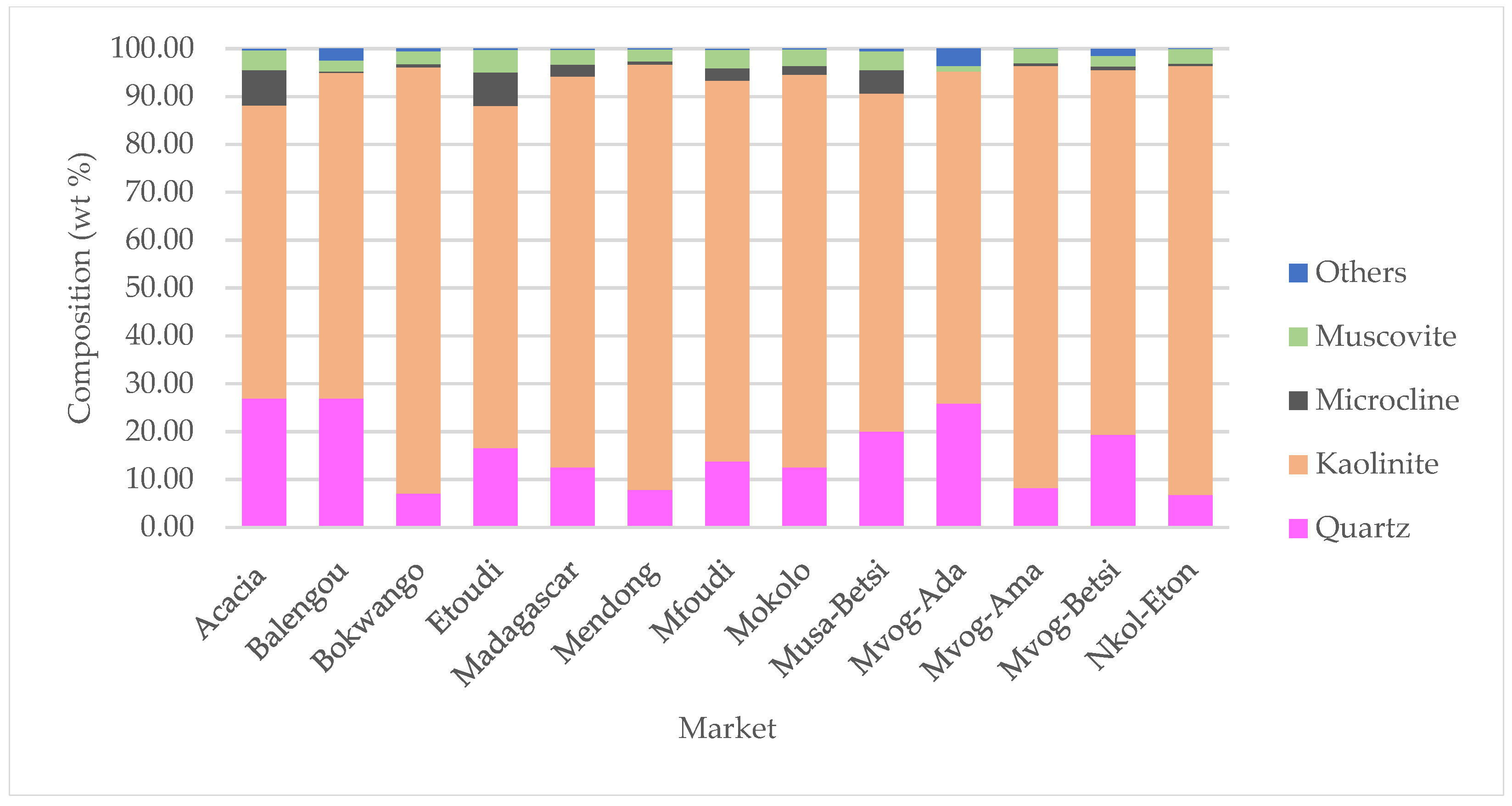



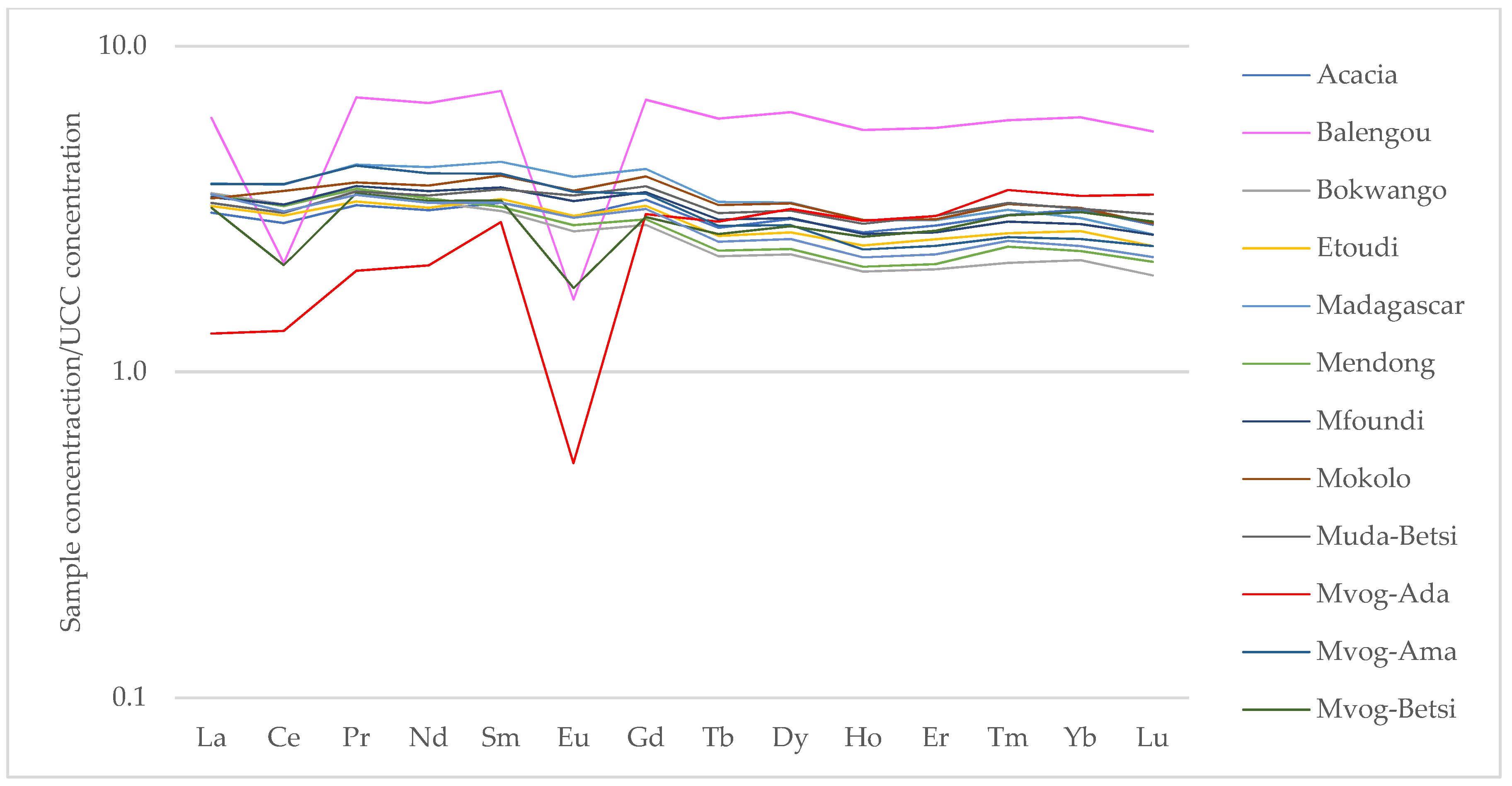


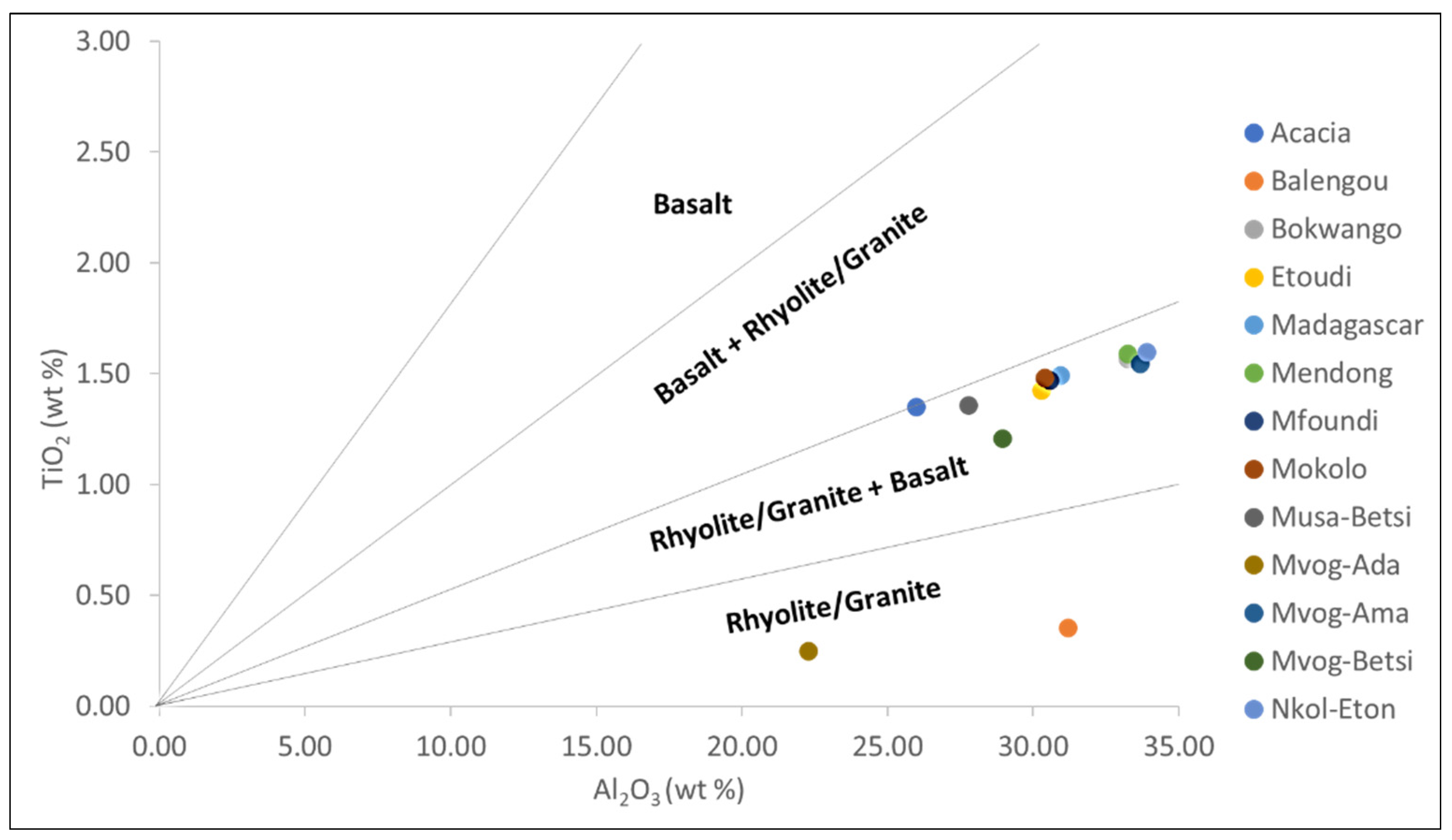



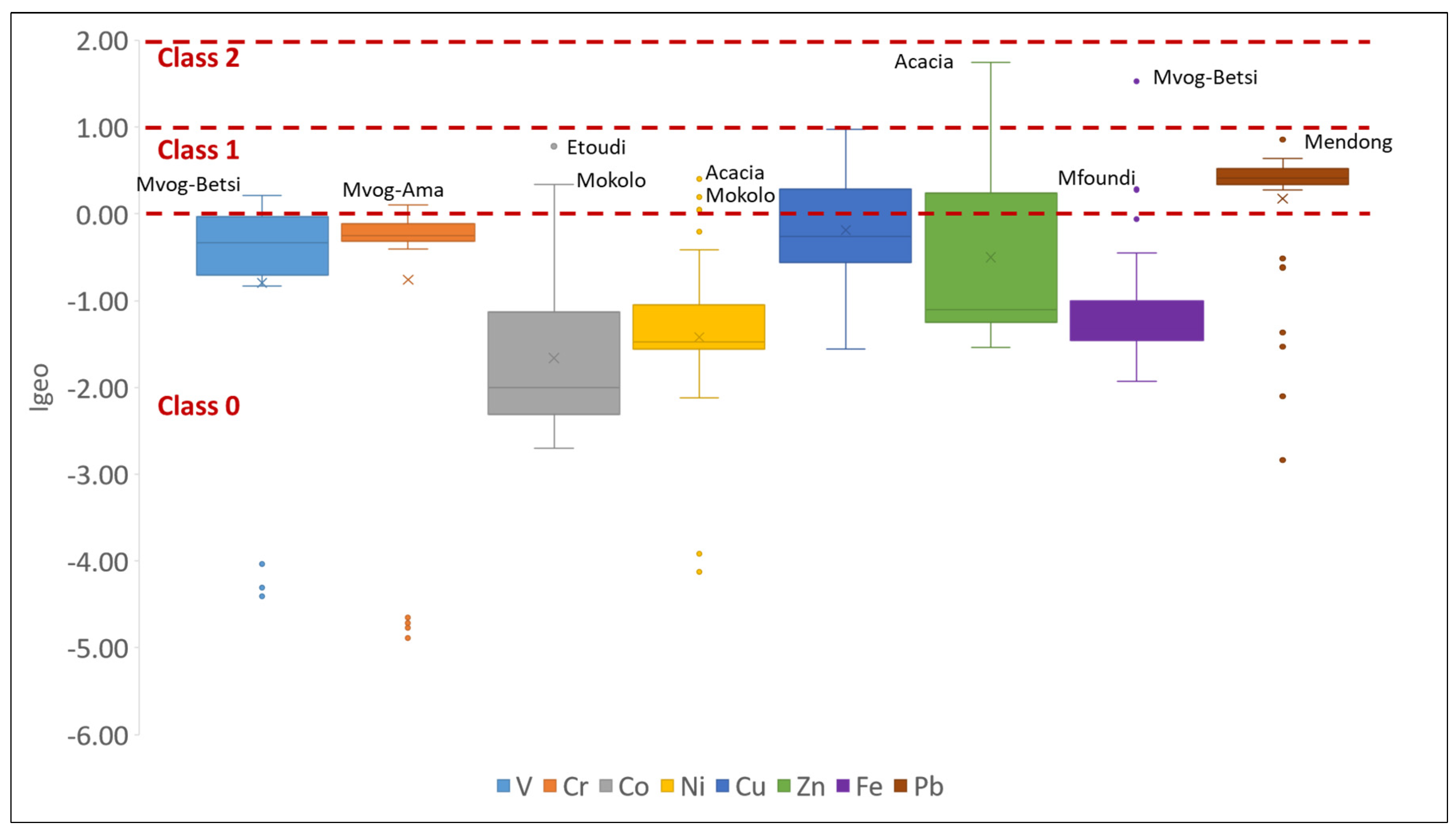

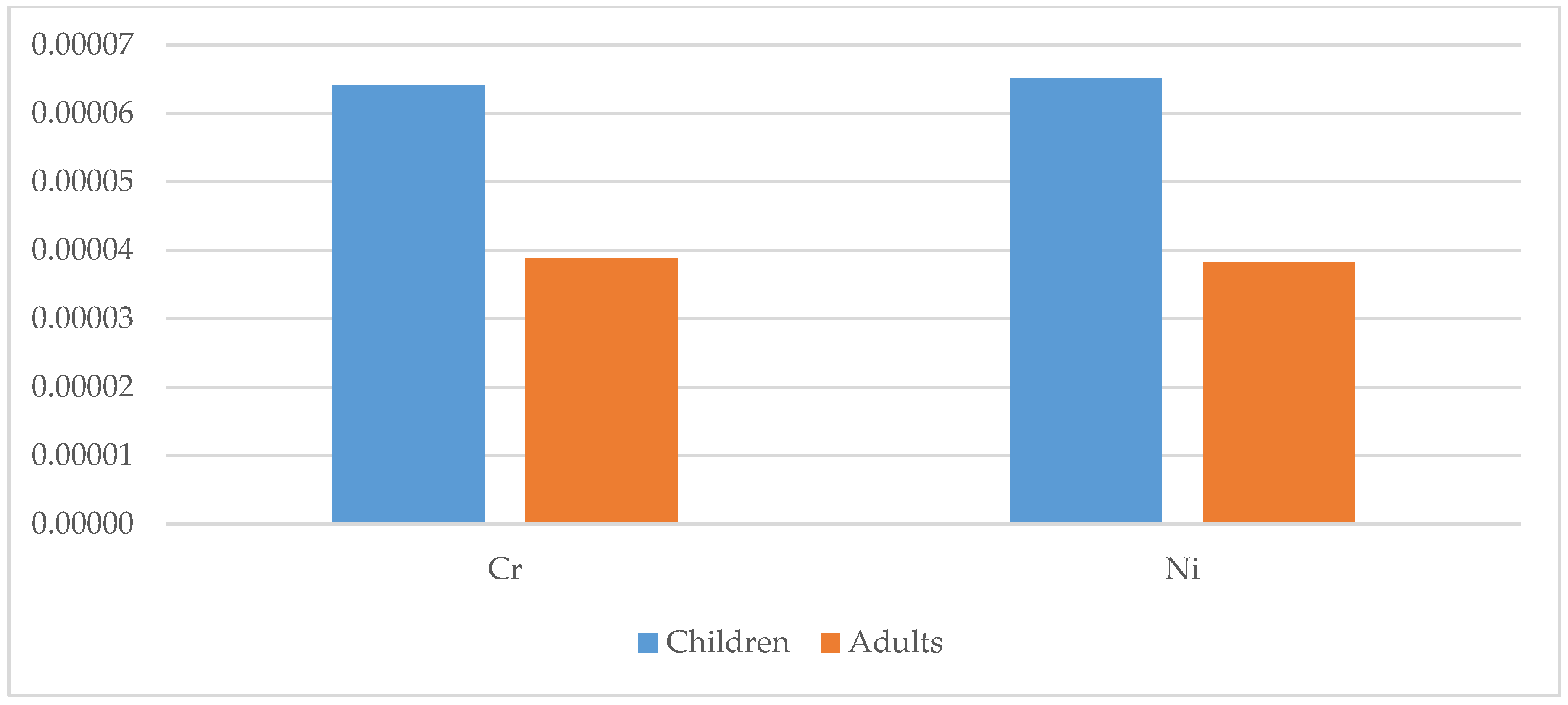
| Market | Coordinates | Sample Codes | Number of Samples |
|---|---|---|---|
| Acacia | 3°50′7.58″ N, 11°29′50.68″ E | S1–S2 | 2 |
| Balengou | 5°5′60.00″ N, 10°25′60.00″ E | S3–S5 | 3 |
| Bokwango | 4°13′4.00″ N, 9°10′24.00″ E | S6–S8 | 3 |
| Etoudi | 3°54′55.61″ N, 11°31′45.33″ E | S9–S10 | 2 |
| Madagascar | 3°52′49.13″ N, 11°29′33.56″ E | S11–S14 | 4 |
| Mendong | 3°49′51.99″ N, 11°28′25.93″ E | S15–S20 | 6 |
| Mfoudi | 3°51′57.86″ N, 11°31′29.24″ E | S21–S24 | 4 |
| Mokolo | 3°52′24.77″ N, 11°29′58.80″ E | S25–S28 | 4 |
| Muda-Betsi | 3°50′53.88″ N, 11°31′9.81″ E | S29 | 1 |
| Mvog-Ada | 3°52′0.80″ N, 11°31′35.20″ E | S30 | 1 |
| Mvog-Ama | 3°51′28.60″ N, 11°28′51.66″ E | S31–S32 | 2 |
| Mvog-Betsi | 3°51′58.68″ N, 11°29′11.59″ E | S33–S36 | 4 |
| Nkol-Eton | 3°53′17.43″ N, 11°31′13.35″ E | S37–S40 | 4 |
| Total | 40 |
| Al2O3/TiO2 | La/Sc | Th/Sc | Th/Co | Th/Cr | Zr/Sc | |
|---|---|---|---|---|---|---|
| Acacia | 19.25 | 3.90 | 1.03 | 0.94 | 0.22 | 23.31 |
| Balengou | 88.26 | 15.20 | 2.51 | 2.59 | 5.86 | 106.02 |
| Bokwango | 21.17 | 4.77 | 1.07 | 5.62 | 0.20 | 13.61 |
| Etoudi | 21.24 | 3.97 | 1.00 | 1.01 | 0.20 | 16.00 |
| Madagascar | 20.69 | 4.85 | 1.00 | 2.71 | 0.21 | 15.23 |
| Mendong | 20.91 | 4.56 | 0.95 | 4.07 | 0.19 | 13.73 |
| Mfoudi | 20.79 | 4.17 | 0.99 | 2.38 | 0.21 | 16.66 |
| Mokolo | 20.50 | 4.54 | 1.06 | 1.69 | 0.20 | 16.97 |
| Musa-Betsi | 20.43 | 4.47 | 1.06 | 0.80 | 0.20 | 20.62 |
| Mvog-Ada | 89.08 | 5.80 | 2.89 | 1.65 | 3.85 | 119.74 |
| Mvog-Ama | 21.79 | 4.19 | 0.89 | 4.03 | 0.17 | 10.85 |
| Mvog-Betsi | 23.98 | 4.97 | 1.35 | 4.51 | 0.27 | 34.10 |
| Nkol-Eton | 21.22 | 4.70 | 1.05 | 3.32 | 0.21 | 13.36 |
| Minimum | 19.25 | 3.90 | 0.89 | 0.80 | 0.17 | 10.85 |
| Maximum | 89.08 | 15.20 | 2.89 | 5.62 | 5.86 | 119.74 |
| Mean | 31.49 | 5.39 | 1.30 | 2.72 | 0.92 | 32.32 |
| Felsic rocks * | >28 | 0.70–27.70 | 0.64–18.1 | 0.3–7.5 | 0.067–4.0 | |
| Mafic rocks * | <14 | 0.40–1.10 | 0.05–0.4 | NA | 0.002–0.045 |
| Non-Carcinogenic | Children | Adults | ||||||
|---|---|---|---|---|---|---|---|---|
| HQ Ingestion | HQ Dermal | HQ Inhalation | HI | HQ Ingestion | HQ Dermal | HQ Inhalation | HI | |
| Fe | ||||||||
| Minimum | 3.54 × 10−5 | 3.54 × 10−5 | 4.04 × 10−6 | 4.04 × 10−6 | ||||
| Maximum | 3.88 × 10−4 | 3.88 × 10−4 | 4.44 × 10−5 | 4.44 × 10−5 | ||||
| Mean | 7.31 × 10−5 | 7.31 × 10−5 | 8.35 × 10−6 | 8.35 × 10−6 | ||||
| Co | ||||||||
| Minimum | 2.49 × 10−3 | 2.49 × 10−3 | 2.85 × 10−4 | 2.85 × 10−4 | ||||
| Maximum | 2.78 × 10−2 | 2.78 × 10−2 | 3.18 × 10−3 | 3.18 × 10−3 | ||||
| Mean | 6.73 × 10−3 | 6.73 × 10−3 | 7.69 × 10−4 | 7.69 × 10−4 | ||||
| Cr | ||||||||
| Minimum | 1.94 × 10−2 | 2.72 × 10−3 | 5.62 × 10−5 | 2.22 × 10−2 | 2.22 × 10−3 | 4.43 × 10−4 | 6.00 × 10−5 | 2.72 × 10−3 |
| Maximum | 6.16 × 10−1 | 8.63 × 10−2 | 1.78 × 10−3 | 7.05 × 10−1 | 7.05 × 10−2 | 1.41 × 10−2 | 1.90 × 10−3 | 8.64 × 10−2 |
| Mean | 4.46 × 10−1 | 6.25 × 10−2 | 1.29 × 10−3 | 5.10 × 10−1 | 5.10 × 10−2 | 1.02 × 10−2 | 1.38 × 10−3 | 6.26 × 10−2 |
| Cu | ||||||||
| Minimum | 4.45 × 10−3 | 4.15 × 10−5 | 1.23 × 10−7 | 4.49 × 10−3 | 5.09 × 10−4 | 6.76 × 10−6 | 1.31 × 10−7 | 5.15 × 10−4 |
| Maximum | 2.58 × 10−2 | 2.40 × 10−4 | 7.10 × 10−7 | 2.60 × 10−2 | 2.94 × 10−3 | 3.92 × 10−5 | 7.58 × 10−7 | 2.98 × 10−3 |
| Mean | 1.25 × 10−2 | 1.17 × 10−4 | 3.45 × 10−7 | 1.26 × 10−2 | 1.43 × 10−3 | 1.90 × 10−5 | 3.68 × 10−7 | 1.45 × 10−3 |
| Ni | ||||||||
| Minimum | 2.53 × 10−3 | 2.62 × 10−5 | 1.55 × 10−5 | 2.57 × 10−3 | 2.89 × 10−4 | 4.27 × 10−6 | 1.65 × 10−5 | 3.10 × 10−4 |
| Maximum | 5.83 × 10−2 | 6.05 × 10−4 | 3.57 × 10−4 | 5.93 × 10−2 | 6.66 × 10−3 | 9.85 × 10−5 | 3.81 × 10−4 | 7.14 × 10−3 |
| Mean | 2.09 × 10−2 | 2.17 × 10−4 | 1.28 × 10−4 | 2.12 × 10−2 | 2.39 × 10−3 | 3.53 × 10−5 | 1.37 × 10−4 | 2.56 × 10−3 |
| Pb | ||||||||
| Minimum | 1.27 × 10−2 | 2.38 × 10−4 | 3.49 × 10−7 | 1.30 × 10−2 | 1.46 × 10−3 | 3.88 × 10−5 | 3.72 × 10−7 | 1.49 × 10−3 |
| Maximum | 1.67 × 10−1 | 3.13 × 10−3 | 4.59 × 10−6 | 1.71 × 10−1 | 1.91 × 10−2 | 5.10 × 10−4 | 4.89 × 10−6 | 1.96 × 10−2 |
| Mean | 1.13 × 10−1 | 2.12 × 10−3 | 3.11 × 10−6 | 1.15 × 10−1 | 1.30 × 10−2 | 3.45 × 10−4 | 3.32 × 10−6 | 1.33 × 10−2 |
| Zn | ||||||||
| Minimum | 1.44 × 10−3 | 2.02 × 10−5 | 3.98 × 10−8 | 1.46 × 10−3 | 1.65 × 10−4 | 3.29 × 10−6 | 4.24 × 10−8 | 1.68 × 10−4 |
| Maximum | 1.40 × 10−2 | 1.96 × 10−4 | 3.86 × 10−7 | 1.42 × 10−2 | 1.60 × 10−3 | 3.19 × 10−5 | 4.12 × 10−7 | 1.63 × 10−3 |
| Mean | 4.10 × 10−3 | 5.75 × 10−5 | 1.13 × 10−7 | 4.16 × 10−3 | 4.69 × 10−4 | 9.36 × 10−6 | 1.21 × 10−7 | 4.79 × 10−4 |
| Carcinogenic | CR ingestion | CR dermal | CR inhalation | TCR | CR ingestion | CR dermal | CR inhalation | TCR |
| Cr | ||||||||
| Minimum | 2.50 × 10−6 | 2.8 × 10−7 | 5.79 × 10−9 | 2.79 × 10−6 | 1.43 × 10−6 | 2.28 × 10−7 | 3.09 × 10−8 | 1.69 × 10−6 |
| Maximum | 7.94 × 10−5 | 8.88 × 10−6 | 1.84 × 10−7 | 8.85 × 10−5 | 4.54 × 10−5 | 7.23 × 10−6 | 9.79 × 10−7 | 5.36 × 10−5 |
| Mean | 5.75 × 10−5 | 6.43 × 10−6 | 1.33 × 10−7 | 6.41 × 10−5 | 3.29 × 10−5 | 5.23 × 10−6 | 7.09 × 10−7 | 3.88 × 10−5 |
| Ni | ||||||||
| Minimum | 7.37 × 10−6 | 5.16 × 10−7 | 1.00 × 10−10 | 7.88 × 10−6 | 4.21 × 10−6 | 4.20 × 10−7 | 5.35 × 10−10 | 4.63 × 10−6 |
| Maximum | 1.70 × 10−4 | 1.19 × 10−5 | 2.31 × 10−9 | 1.82 × 10−4 | 9.71 × 10−5 | 9.68 × 10−6 | 1.23 × 10−8 | 1.07 × 10−4 |
| Mean | 6.09 × 10−5 | 4.26 × 10−6 | 8.29 × 10−10 | 6.51 × 10−5 | 3.48 × 10−5 | 3.47 × 10−6 | 4.42 × 10−9 | 3.83 × 10−5 |
| Pb | ||||||||
| Minimum | 3.25 × 10−8 | 3.2 × 10−8 | 1.86 × 10−8 | 1.86 × 10−8 | ||||
| Maximum | 4.27 × 10−7 | 4.3 × 10−7 | 2.44 × 10−7 | 2.44 × 10−7 | ||||
| Mean | 2.89 × 10−7 | 2.9 × 10−7 | 1.65 × 10−7 | 1.65 × 10−7 | ||||
Publisher’s Note: MDPI stays neutral with regard to jurisdictional claims in published maps and institutional affiliations. |
© 2021 by the authors. Licensee MDPI, Basel, Switzerland. This article is an open access article distributed under the terms and conditions of the Creative Commons Attribution (CC BY) license (https://creativecommons.org/licenses/by/4.0/).
Share and Cite
Ekosse, G.-I.; Nkeng, G.E.; Bukalo, N.; Oyebanjo, O. Geophagic Clays from Cameroon: Provenance, Metal Contamination and Health Risk Assessment. Int. J. Environ. Res. Public Health 2021, 18, 8315. https://doi.org/10.3390/ijerph18168315
Ekosse G-I, Nkeng GE, Bukalo N, Oyebanjo O. Geophagic Clays from Cameroon: Provenance, Metal Contamination and Health Risk Assessment. International Journal of Environmental Research and Public Health. 2021; 18(16):8315. https://doi.org/10.3390/ijerph18168315
Chicago/Turabian StyleEkosse, Georges-Ivo, George Elambo Nkeng, Nenita Bukalo, and Olaonipekun Oyebanjo. 2021. "Geophagic Clays from Cameroon: Provenance, Metal Contamination and Health Risk Assessment" International Journal of Environmental Research and Public Health 18, no. 16: 8315. https://doi.org/10.3390/ijerph18168315
APA StyleEkosse, G.-I., Nkeng, G. E., Bukalo, N., & Oyebanjo, O. (2021). Geophagic Clays from Cameroon: Provenance, Metal Contamination and Health Risk Assessment. International Journal of Environmental Research and Public Health, 18(16), 8315. https://doi.org/10.3390/ijerph18168315






